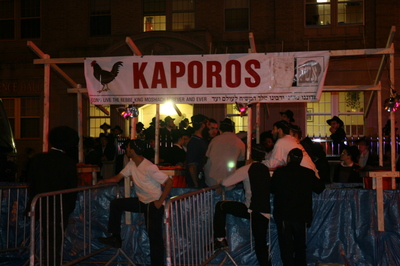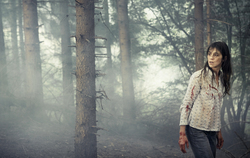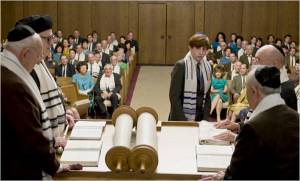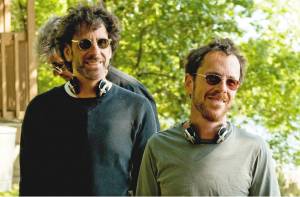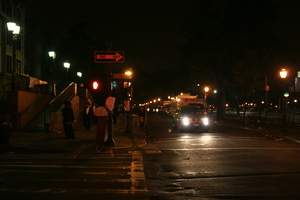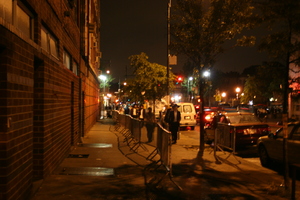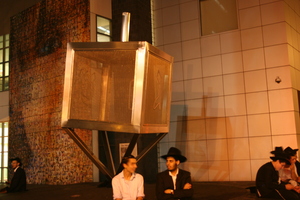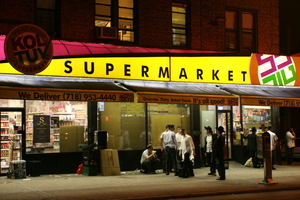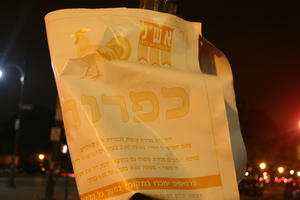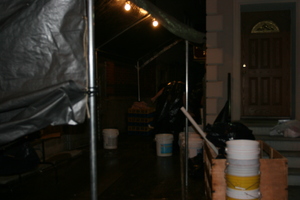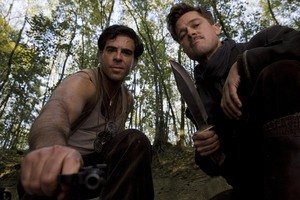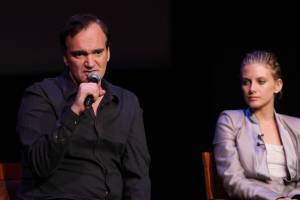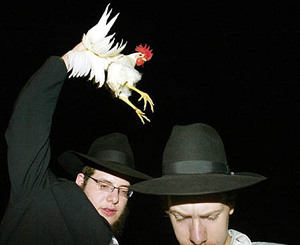A tall, bearded, bespectacled man wraps his gloved hand firmly around the neck of a hen. Bird in tow, he approaches his cherubic 7-year-old daughter and raises the chicken high above his daughter’s head. The young child flinches and shrieks in the face of the frantic, wing-flapping fowl. The man circles the elevated hen around his daughter’s head three times while reciting an ancient chant in Yiddish—a chant echoed by his offspring. The hen is then handed over to a burly butcher in a green jumpsuit wielding a shimmering razor, his shaggy beard and scalp obscured by plastic hairnets. In a swift horizontal motion, the hen’s throat is slashed, and blood slowly drips down its twitching shanks.
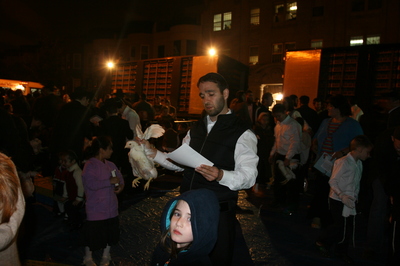
An Orthodox Jewish man swings a chicken over his daughter's head during the kaparot ritual in Crown Heights, Brooklyn. Photo: Marlow Stern
This is the ritual of kaparot – sometimes spelled kapparos or kapparot – whereby Orthodox Jews take live chickens, swing them over their heads as a means of transferring their sins onto the chickens, and then have them slaughtered on the eve of Yom Kippur, the Jewish day of atonement. This year, Yom Kippur falls on September 28. The idea behind this practice is that the animal dies in the person’s stead, and when its throat is slit, the soul slowly departs into the night sky. The ritual is a family affair, and evidence that the tight-knit Orthodox Jewish community continues to cling to their beliefs, however contrary to the zeitgeist.
“The point of kaparot is an exchange,” said Rabbi Chayim B. Alevsky of the West Side Chabad, while cradling a child in his office. “If something sinful was meant to happen to us in the coming year, God should save us, and it should be atoned for through the death of this chicken. We will then be elevated spiritually, because the chicken is later donated to feed the poor.”
Today, kaparot is performed in only Haredi – or Ultra-Orthodox – Jewish communities. In New York City, the largest kaparot ceremony occurs along Kingston Avenue in Crown Heights, Brooklyn.
At 9:30 p.m. Saturday – the eve of Yom Kippur – a large truck housing about 2,000 chickens, packed four to a crate, arrived at the site on Kingston Ave. Bright spotlights shone down on the gated-off city street, as a gaggle of puzzled policemen looked on. A long line of Jews in Hasidic garb has formed. The men have beards, yarmulkes and dark jackets/trousers, while the women don headscarves (tichels), long, conservative skirts, and sleeves past the elbow. They have lined up to purchase chicken tickets for $10 apiece. These tickets are then taken to the trucks, where the crateboys hand you your rooster (for a man) or hen (for a woman).
It’s a family affair said Pini Althaus, a 35-year-old father of two. Pini claims that kaparot is a very enlightening ritual for his young daughters, Loni, 7, and Basi, 10. “They know they could’ve done certain things throughout the year that could’ve warranted better behavior,” said Pini. “They understand that they’ve got to behave throughout the rest of the year.”
But is Pini’s youngest daughter excited about the chicken-swinging ceremony? “No,” said Loni, a cute girl with curly brown hair and a cherubic face. She then turned to her mother Chaya Althaus, absorbed her disapproving glare, and exclaimed, “Yeah, yeah I am. Because it’s fun!”
Orthodox Jewish children are taught about the history of kaparot in Hebrew School from a very young age. “They came home with fake chickens they made in arts and crafts,” said Pessi Schochet, a 35-year-old mother of two from Crown Heights. “Our youngest boy is only two, and he came home with one and he knew about it.” She then points to her drooling toddler fast asleep in a stroller. “It’s upsetting that he passed out!”
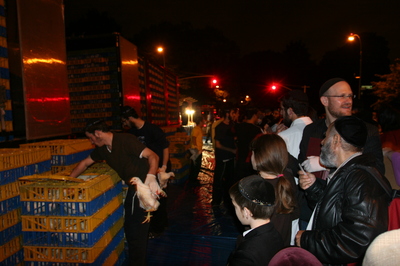
A gaggle of Orthodox Jews wait to redeem their tickets for chickens at the kaparot ceremony in Crown Heights, Brooklyn. Photo: Marlow Stern
Despite the family-friendly nature of the Crown Heights ritual, the tradition of kaparot has come under heavy fire from animal rights groups. In 2005, a number of caged chickens were abandoned in rainy weather following a kaparot ceremony in Brooklyn. Jacob Kalish, an Orthodox Jewish man from Williamsburg, was charged with animal cruelty for the drowning deaths of 35 of these kaparot chickens.
“We oppose how the birds are treated before, during, and after the ceremony, including holding the birds in crates, without sustenance or shelter or any show of care or compassion, for days leading up to the ritual,” said Karen Davis, President of United Poultry Concerns, whose aim is to promote the compassionate and respectful treatment of domestic fowl. “We object to the callous way practitioners hold the chickens with their wings pulled back, which puts the chicken at risk of ligament and tendon injury, and possible bone fracture.”
It’s not just animal rights activists who oppose the practice of kaparot. The ritual has even been denounced by fellow, non-Haredi Jewry, who prefer the use of money instead of chickens on the grounds of tza’ar ba’alei chayim (unnecessary pain to animals). “Normative Jewry, we don’t do that now,” said Cantor Sherwood Goffin of Lincoln Square Synagogue in his spacious office. “We just take charity. And because I am giving to charity, may that charity be to my merit.”
The Torah teaches Jews that all of God’s lesser creatures are here to serve humanity. And the kosher slaughter of the chicken is painless, according to onlooker Benad Evenchen, a 22-year-old visitor from Israel. “The neck has a place where you cut it, and when the knife is very, very sharp, it doesn’t hurt and doesn’t harm the soul of the chicken,” said Evenchen. “We have to understand that what we see here is the Will of God.”
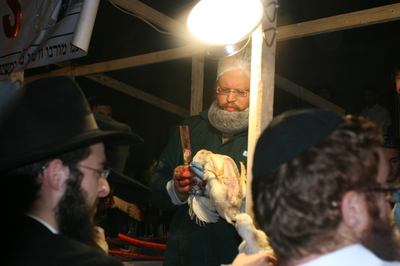
A kosher butcher slaughters a chicken with a razor during the kaparot ritual in Crown Heights, Brooklyn. Photo: Marlow Stern
With hundreds of Jews packed into a site a quarter of the size of a city block, it’s a particularly odd ceremony for Orthodox Jewish women. “Usually men and women are separated, but tonight, I feel like I’ve been bumped by so many men,” said Yocheved Amrami, a 28-year-old Jewish woman hugging a rail far from the action. Amrami feels the actual act of swinging can be overwhelming for young children. “It’s little kids who don’t know how to treat animals well, and it’s nerve-wracking,” said Amrami. She also objects on fecal grounds, adding, “And they could poop on you, cause they’re so nervous, they freak out!”
For a ceremony that has such solemn connotations, the act of swinging a chicken seems more than a little bizarre. “Kaparot is absolutely the funniest custom we have, hands down,” said Rabbi Alevsky. “There’s plenty of giggling and laughing going around, and there’s a lot of shrieking, ‘I don’t want to touch it!’ ‘Get it away from me!’” He pauses, before adding, “And the chicken often poops on people. It chooses its targets very carefully.”

